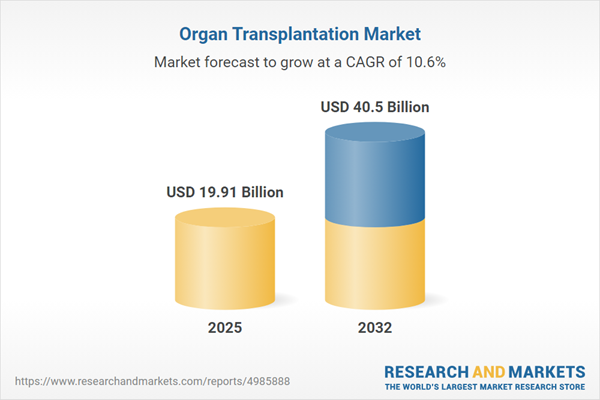Speak directly to the analyst to clarify any post sales queries you may have.
The organ transplantation market is evolving rapidly, shaped by advancements in medical technology, growing healthcare demands, and complex supply chains. As healthcare leaders navigate new policy landscapes and increasingly sophisticated treatment modalities, strategic insight is essential for effective decision-making and sustainable growth in transplantation services.
Market Snapshot: Organ Transplantation Market Growth and Dynamics
The organ transplantation market grew from USD 18.11 billion in 2024 to USD 19.91 billion in 2025. With an expected CAGR of 10.57%, the market is projected to reach USD 40.50 billion by 2032, signifying robust expansion. This momentum reflects innovation across surgical techniques, device platforms, and pharmaceutical interventions, coupled with heightened attention on equitable resource allocation and expanding global access.
Scope & Segmentation of the Organ Transplantation Market
This comprehensive report evaluates the market through a detailed segmentation framework, reflecting the diverse operational and clinical environments within the sector:
- Type of Organ: Heart, kidney, liver, lung, and pancreas transplantation, each with unique therapeutic approaches and care priorities.
- Product Type: Immunosuppressive drugs, organ perfusion systems, preservation solutions, surgical instruments & accessories, and transplant diagnostics & monitoring tools—underscoring the critical importance of technology selection and integration.
- Source of Organs: Deceased and living donors, highlighting logistical and ethical distinctions that influence supply chain strategies and patient pathways.
- End-User: Ambulatory surgical centers, hospitals, and transplantation centers, representing varied adoption profiles and infrastructure needs.
- Regional Coverage: Americas (North America and Latin America), Europe, Middle East & Africa (including key EU, Gulf, and African economies), and Asia-Pacific (including high-growth markets such as China, India, and Australia).
- Leading Companies: 21st Century Medicine, Abbott Laboratories, Novartis AG, Medtronic PLC, Sanofi S.A., Stryker Corporation, TransMedics Group, Inc., and other major innovators spanning pharmaceuticals, devices, and diagnostics.
Key Takeaways: Strategic Insights for Senior Decision-Makers
- Technological innovation is transforming transplantation outcomes, with advancements in perfusion, preservation, and monitoring extending organ viability and enhancing patient care models.
- Policy reform and cross-sector partnerships are supporting accelerated pathways for device approval and fostering collaboration among clinical, regulatory, and industry stakeholders.
- Digital health and artificial intelligence platforms are being increasingly adopted for early detection, patient monitoring, and communication between multidisciplinary teams, enabling more proactive management of transplant recipients.
- The competitive landscape is characterized by alliances between pharmaceutical, device, and diagnostics leaders, aiming for integrated, data-driven solutions and real-world evidence generation.
- Donor diversity and end-user segmentation drive differentiated infrastructure requirements and service models, indicating the importance of context-driven product strategies in local markets.
Tariff Impact: Navigating Regulatory and Supply Chain Challenges
Impending US tariff adjustments for 2025 are expected to affect procurement costs for transplant centers due to increased duties on imported devices and pharmaceuticals. Organizations are reevaluating supplier relationships, exploring domestic manufacturing, and forging new partnerships to address potential delays and cost pressures in the supply chain. Healthcare providers are conducting scenario planning and building inventory buffers to maintain continuity in transplantation services. Intensified advocacy efforts aim to mitigate negative implications for patient access and sector resilience.
Methodology & Data Sources
This report integrates structured interviews with transplant surgeons, procurement managers, device developers, and regulatory experts, supported by a thorough review of peer-reviewed journals, regulatory documents, and industry white papers. Both qualitative and quantitative data were validated through triangulation and assessment by an expert review panel to ensure reliability and objectivity.
Why This Report Matters: Informed Decisions and Improved Outcomes
- Provides actionable intelligence for investment, clinical expansion, and operational resilience in organ transplantation.
- Enables supply chain risk mitigation and the identification of emerging opportunities in response to regulatory and technological change.
- Supports strategic planning by highlighting best practices in cross-sector collaboration and innovation adoption within the transplantation value chain.
Conclusion: Charting Strategic Pathways in Organ Transplantation
The organ transplantation market is shaped by rapid technological advancements, evolving policy climates, and dynamic global partnerships. This report empowers senior leadership to navigate sector complexities, foster innovation, and drive positive patient and business outcomes across diverse healthcare settings.
Additional Product Information:
- Purchase of this report includes 1 year online access with quarterly updates.
- This report can be updated on request. Please contact our Customer Experience team using the Ask a Question widget on our website.
Table of Contents
3. Executive Summary
4. Market Overview
7. Cumulative Impact of Artificial Intelligence 2025
Companies Mentioned
The companies profiled in this Organ Transplantation market report include:- 21st Century Medicine
- Abbott Laboratories
- AbbVie Inc.
- Astellas Pharma Inc.
- Bio-Rad Laboratories, Inc.
- BiolifeSolutions, Inc.
- Bridge to Life Ltd.
- Bristol-Myers Squibb Company
- CHIESI Farmaceutici S.p.A.
- Dr. Franz Kohler Chemie GmbH
- eGenesis Inc.
- F. Hoffmann-La Roche Ltd
- Illumina, Inc.
- Medtronic PLC
- Novartis AG
- Organ Recovery Systems, Inc.
- Organovo, Inc.
- OrganOx Limited
- Pfizer Inc.
- Plexision, Inc.
- Preservation Solutions, Inc.
- Sanofi S.A.
- Stryker Corporation
- Terumo Corporation
- Teva Pharmaceuticals Industries Ltd.
- Thermo Fisher Scientific Inc.
- TransMedics Group, Inc.
- United Therapeutics Corporation
- Veloxis Pharmaceuticals, Inc. by Asahi Kasei Corp.
- Vivalyx GmbH
- Xvivo Perfusion AB
Table Information
| Report Attribute | Details |
|---|---|
| No. of Pages | 184 |
| Published | November 2025 |
| Forecast Period | 2025 - 2032 |
| Estimated Market Value ( USD | $ 19.91 Billion |
| Forecasted Market Value ( USD | $ 40.5 Billion |
| Compound Annual Growth Rate | 10.5% |
| Regions Covered | Global |
| No. of Companies Mentioned | 32 |









